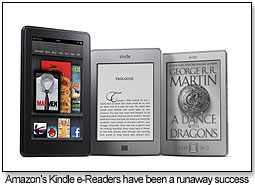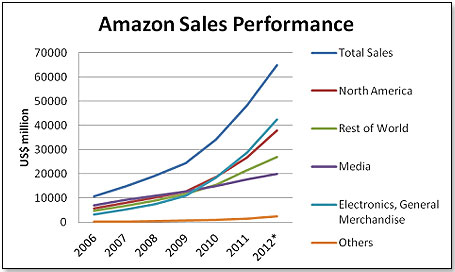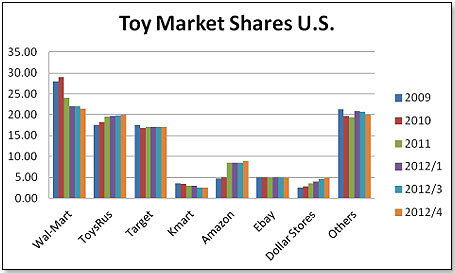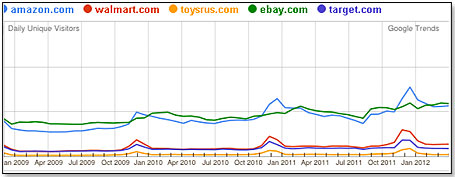
April 24, 2024


 Update from May 3, 2012, based on latest Amazon reported earnings:
Update from May 3, 2012, based on latest Amazon reported earnings: This in essence meant that the publishers had two choices. One was to go for Amazon’s $9.99 level, which meant that they could pocket only the 70% of this price, e.g. $6.99. This was not practical, since their costs are clearly higher than this price. The other choice was to gang up on Amazon and to force the company to raise its price from the $9.99 level to something more realistic like $13.00.
This in essence meant that the publishers had two choices. One was to go for Amazon’s $9.99 level, which meant that they could pocket only the 70% of this price, e.g. $6.99. This was not practical, since their costs are clearly higher than this price. The other choice was to gang up on Amazon and to force the company to raise its price from the $9.99 level to something more realistic like $13.00. 


| Category | Company | Product | AmazonUS $ | ToysRUsUS$ | ToysRUswith tax US$ |
| Action Figures | Hasbro | Avengers Gamma Green HulkSmash Fist Combo | 23.07 | 19.99 | 21.91 |
| Action Figures | Hasbro | Transformers BumbleBee L | 20.98 | 27.98 | 30.67 |
| Action Figures | Hasbro | Transformers BumbleBee S | 7.97 | 8.99 | 9.85 |
| Action Figures | Jakks | Monsuno Core Lock | 9.99 | 10.99 | 12.05 |
| Building | Hasbro | Kre-O Transformers Optimus | 9.99 | 8.99 | 9.85 |
| Building | Lego | Lego Friends City Park Café | 29.95 | 39.99 | 43.83 |
| Fashion Dolls | Mattel | Barbie Tawny Horse | 24.99 | 42.99 | 47.12 |
| Fashion Dolls | MGA | Bratz Catz Doll Sasha | 19.99 | 19.99 | 21.91 |
| Games | Hasbro | Monopoly Electronic | 24.98 | 27.99 | 30.68 |
| Games | Hasbro | Sorry | 17.12 | 17.99 | 19.72 |
| Games | Lego | Ninjago | 24.89 | 20.99 | 23.01 |
| Girls | Hasbro | Littlest Petshop Ultimate PetCollection | 23.00 | 19.99 | 21.91 |
| Learning | Leapfrog | Leappad Explorer | 97.75 | 99.99 | 109.59 |
| Learning | VTech | Mobigo | 47.49 | 59.99 | 65.75 |
| Outdoor | Hasbro | Nerf Vortex Lumitron | 24.98 | 31.99 | 35.06 |
| Preschool | Hasbro | Sesame Elmo 15’ | 16.95 | 20.99 | 23.01 |
| Preschool | Mattel | Imaginext Triceratops | 16.99 | 17.99 | 19.71 |
| Vehicles | Mattel | Hotwheels w Cars Gift Pack | 21.99 | 21.99 | 24.10 |
| Total | 463.07 | 516.81 | 566.42 |
For years, Texans have been buying things on Amazon tax-free. Lawmakers recently closed a loophole that allowed online retailers to get around collecting sales tax. Lauren Willis with the Texas Comptroller of Public Accounts says that previous negotiations with Amazon didn't go anywhere. “We resumed talks about probably two, to two-and-a-half weeks ago. And they agreed, starting July 1st, to start collecting those taxes." The State of Texas is still calculating exactly how much extra revenue it can count on, once Amazon starts collecting sales tax. A University of Tennessee study found that untaxed sales over the Internet have cost states $52 billion in lost revenue over the last six years.
Copyright © 2024 TDmonthly®, a division of TOYDIRECTORY.com®,
Inc.